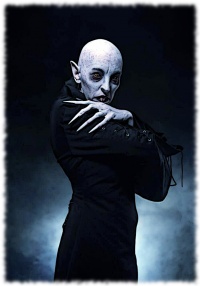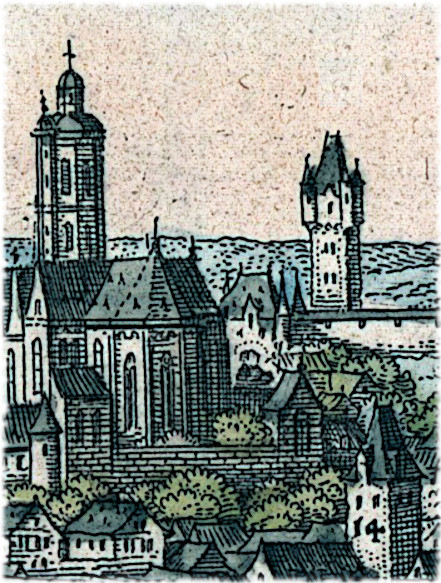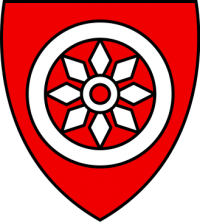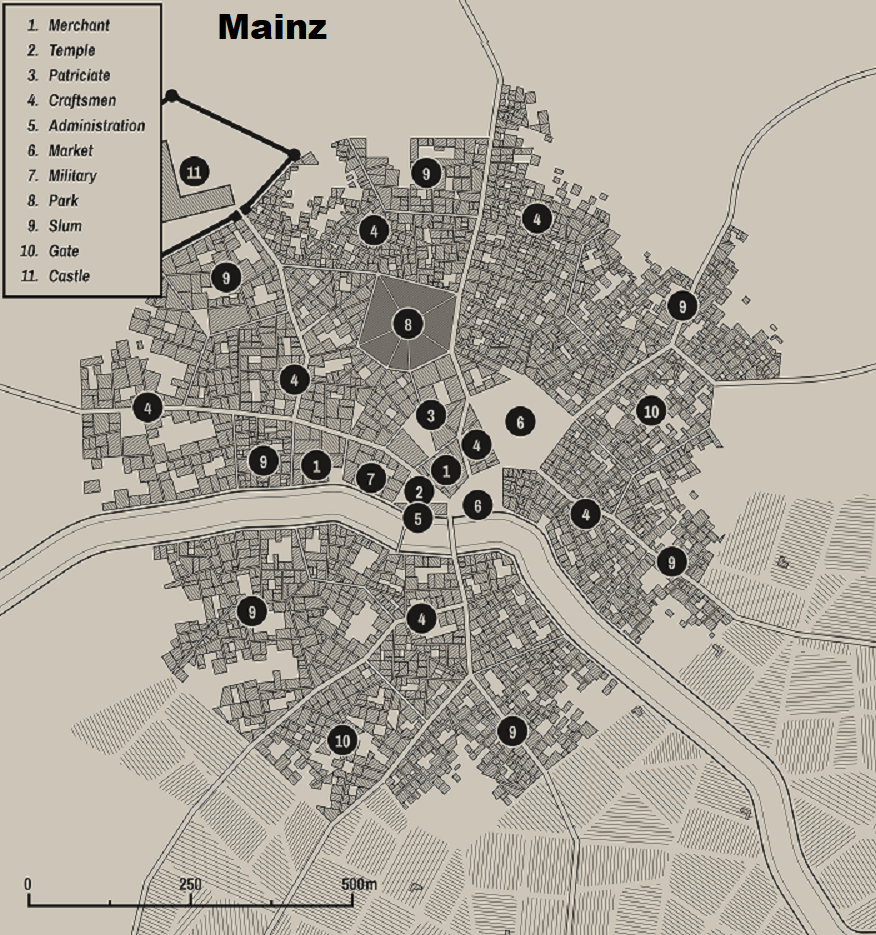Difference between revisions of "Mainz"
(→Taverns) |
(→Die Blutsauger von Mainz) |
||
| (29 intermediate revisions by 2 users not shown) | |||
| Line 11: | Line 11: | ||
== '''Appearance''' == | == '''Appearance''' == | ||
| + | [[File:Mainz medieval.jpg]] | ||
---- | ---- | ||
<br> | <br> | ||
<br> | <br> | ||
---- | ---- | ||
| + | |||
== '''Climate''' == | == '''Climate''' == | ||
Mainz generally features mild summers and mild winters, with a relatively narrow annual temperature range and few extremes of temperature, with temperatures varying between (72 °F) in the warmest month, and above (32 °F) in the coldest month. Rain fall is also moderate, falling regularly and evenly across the seasons. | Mainz generally features mild summers and mild winters, with a relatively narrow annual temperature range and few extremes of temperature, with temperatures varying between (72 °F) in the warmest month, and above (32 °F) in the coldest month. Rain fall is also moderate, falling regularly and evenly across the seasons. | ||
| Line 48: | Line 50: | ||
== '''Geography''' == | == '''Geography''' == | ||
| − | [[]] | + | [[File:Mainz 2.0.png]] |
<br> | <br> | ||
<br> | <br> | ||
| Line 93: | Line 95: | ||
In 1244, Archbishop Siegfried III granted Mainz a city charter, which included the right of the citizens to establish and elect a city council. The city saw a feud between two archbishops in 1461, namely Diether von Isenburg, who was elected Archbishop by the cathedral chapter and supported by the citizens, and Adolf II von Nassau, who had been named archbishop for Mainz by the pope. In 1462, the Archbishop Adolf raided the city of Mainz, plundering and killing 400 inhabitants. At a tribunal, those who had survived lost all their property, which was then divided between those who promised to follow Adolf. Those who would not promise to follow Adolf (amongst them Johannes Gutenberg) were driven out of the town or thrown into prison. The new archbishop revoked the city charter of Mainz and put the city under his direct rule. Ironically, after the death of Adolf II his successor was again Diether von Isenburg, now legally elected by the chapter and named by the Pope. | In 1244, Archbishop Siegfried III granted Mainz a city charter, which included the right of the citizens to establish and elect a city council. The city saw a feud between two archbishops in 1461, namely Diether von Isenburg, who was elected Archbishop by the cathedral chapter and supported by the citizens, and Adolf II von Nassau, who had been named archbishop for Mainz by the pope. In 1462, the Archbishop Adolf raided the city of Mainz, plundering and killing 400 inhabitants. At a tribunal, those who had survived lost all their property, which was then divided between those who promised to follow Adolf. Those who would not promise to follow Adolf (amongst them Johannes Gutenberg) were driven out of the town or thrown into prison. The new archbishop revoked the city charter of Mainz and put the city under his direct rule. Ironically, after the death of Adolf II his successor was again Diether von Isenburg, now legally elected by the chapter and named by the Pope. | ||
| + | |||
| + | === May of 1096 === | ||
| + | [[File:Mainz month of may.jpg]] | ||
---- | ---- | ||
<br> | <br> | ||
| Line 128: | Line 133: | ||
=== Citizens of Mainz === | === Citizens of Mainz === | ||
:'''[[Ruthard]]''' -- ''Archbishop of Mainz'' | :'''[[Ruthard]]''' -- ''Archbishop of Mainz'' | ||
| − | :'''Emmeran''' -- ''Commander of the Archbishop's Guard'' | + | :'''[[Emmeran]]''' -- ''Commander of the Archbishop's Guard'' |
==== Jews of Mainz ==== | ==== Jews of Mainz ==== | ||
| Line 148: | Line 153: | ||
==== Crusaders ==== | ==== Crusaders ==== | ||
| − | :'''[[Clarembald of Vendeuil]]''' -- | + | :[[File:Mortal Clarembald of Vendeuil.jpg|200px]] -- '''[[Clarembald of Vendeuil]]''' -- |
| − | :'''[[Thomas, Lord of Coucy]]''' -- | + | :[[File:Mortal Thomas, Lord of Coucy.jpg|200px]] -- '''[[Thomas, Lord of Coucy]]''' -- |
---- | ---- | ||
<br> | <br> | ||
| Line 161: | Line 166: | ||
---- | ---- | ||
== '''Fortifications''' == | == '''Fortifications''' == | ||
| − | :* Zitadelle | + | :* [[Zitadelle of Mainz]] |
---- | ---- | ||
<br> | <br> | ||
| Line 194: | Line 199: | ||
== '''Inns''' == | == '''Inns''' == | ||
| − | :* '''[[()]]''' > -- | + | :* '''[[Das gebrochene Schwert (The Broken Sword)]]''' > -- An inn with an unsavory reputation, minstrel's are rare, but drunken prostitutes sing all night long. |
:* '''[[Die Krönungsfichte (The Crowning Spruce)]]''' > -- A common inn, on most nights a minstrel. A few pretty prostitutes. | :* '''[[Die Krönungsfichte (The Crowning Spruce)]]''' > -- A common inn, on most nights a minstrel. A few pretty prostitutes. | ||
| − | :* '''[[()]]''' > -- | + | :* '''[[Das Rosenhaus (The House of Roses)]]''' > -- Mainz's finest inn, prostitutes are not allowed, but women of taste visit often and only the best jongleur perform here. |
| − | |||
<br> | <br> | ||
<br> | <br> | ||
| Line 208: | Line 212: | ||
---- | ---- | ||
== '''Monuments''' == | == '''Monuments''' == | ||
| − | :* ''Drususstein'' (Drusus stone) - Drusus' mausoleum | + | :* '''[[Drususstein]]''' (Drusus stone) - Drusus' mausoleum |
:* ''Jupiter's column'' | :* ''Jupiter's column'' | ||
:* ''Roman Theater of Mogontiacum'' | :* ''Roman Theater of Mogontiacum'' | ||
| Line 217: | Line 221: | ||
<br> | <br> | ||
---- | ---- | ||
| + | |||
| + | == '''Orphanages''' == | ||
| + | :* House of Saint Stylianos | ||
== '''Private Residences''' == | == '''Private Residences''' == | ||
| Line 224: | Line 231: | ||
---- | ---- | ||
== '''Shops''' == | == '''Shops''' == | ||
| − | :'''[[Der Holzschuppen]]''' -- A toy shop | + | :'''[[Der Holzschuppen (The Woodshed)]]''' -- A medieval toy shop |
| − | :'''[[Der Kleiderschrank]]''' -- A Medieval Tailor | + | :'''[[Der Kleiderschrank (The Wardrobe)]]''' -- A Medieval Tailor |
| − | :'''[[Das Lebkuchenhaus]]''' -- A Confectioner's shop | + | :'''[[Das Lebkuchenhaus (The Gingerbread House)]]''' -- A Confectioner's shop |
---- | ---- | ||
<br> | <br> | ||
| Line 233: | Line 240: | ||
== '''Taverns''' == | == '''Taverns''' == | ||
| − | :* '''[[()]]''' > -- | + | :* '''[[Das Jagdmädchen (The Hunting Maiden)]]''' > -- A dangerous and unsavory tavern, only the desperate or wicked frequent the Maiden. |
| − | :* '''[[()]]''' > -- | + | :* '''[[Die fliegende Katze (The Flying Cat)]]''' > -- A common tavern, |
:* '''[[In der Nähe der Kirche (Near the Church) Tavern]]''' -- Good Tavern, food, drink, most nights a minstrel. A dozen good prostitutes, rooms for rent. | :* '''[[In der Nähe der Kirche (Near the Church) Tavern]]''' -- Good Tavern, food, drink, most nights a minstrel. A dozen good prostitutes, rooms for rent. | ||
---- | ---- | ||
| Line 245: | Line 252: | ||
:[[File:Nosferatu Arcadius.jpg|200px]] - [[Arcadius]] -- ''Der Verräter'' (''The Betrayer'') -- '''Prince''' | :[[File:Nosferatu Arcadius.jpg|200px]] - [[Arcadius]] -- ''Der Verräter'' (''The Betrayer'') -- '''Prince''' | ||
:[[File:Malkavian Hroderich.jpg|200px]] - [[Hroderich]] -- ''Der verrückte Spielzeugmacher'' (''The Mad Toymaker'') | :[[File:Malkavian Hroderich.jpg|200px]] - [[Hroderich]] -- ''Der verrückte Spielzeugmacher'' (''The Mad Toymaker'') | ||
| − | :[[File: | + | :[[File:Eisenwolf Warduz.jpg|200px]] - [[Warduz]] -- ''Das Tier von Mainz'' (''The Beast of Mainz'') |
| + | |||
=== Die Reinen Blutlinien === | === Die Reinen Blutlinien === | ||
| − | :[[ |200px]] - [[Amalasuintha]] -- ''Der Bewahrer der Zeit'' (''The Keeper of Time'') | + | :[[File:True Brujah Amalasuintha.jpg|200px]] - [[Amalasuintha]] -- ''Der Bewahrer der Zeit'' (''The Keeper of Time'') |
| − | :[[ |200px]] - [[Gabi Szombathy]] -- ''Die Zuckerhexe'' (''The Sugar Witch'') [Lennebergwald] | + | :[[File:Tzimisce Gabi Szombathy awake.jpg|200px]] - [[Gabi Szombathy]] -- ''Die Zuckerhexe'' (''The Sugar Witch'') [Lennebergwald] |
| − | :[[ |200px]] - [[Giltbert]] -- ''Der unsterbliche Schneider'' (''The Immortal Tailor'') | + | :[[File:Toreador Giltbert.jpg|200px]] - [[Giltbert]] -- ''Der unsterbliche Schneider'' (''The Immortal Tailor'') |
| Line 257: | Line 265: | ||
:[[ |200px]] - [[]] -- '''' | :[[ |200px]] - [[]] -- '''' | ||
:[[ |200px]] - [[]] -- '''' | :[[ |200px]] - [[]] -- '''' | ||
| + | |||
| + | |||
| + | === Die Alten === | ||
| + | :[[]] - [[Inanna]] - Mad Ancient in Torpor | ||
---- | ---- | ||
<br> | <br> | ||
Latest revision as of 23:21, 13 March 2021
[[]]
Contents
- 1 Quote
- 2 Appearance
- 3 Climate
- 4 Coat of Arms
- 5 Economy
- 6 Geography
- 7 History
- 8 Population
- 9 Cemeteries
- 10 Fortifications
- 11 Geister
- 12 Holy Ground
- 13 Inns
- 14 Law & Lawlessness
- 15 Monuments
- 16 Orphanages
- 17 Private Residences
- 18 Shops
- 19 Taverns
- 20 Die Blutsauger von Mainz
- 21 Whore Houses
- 22 Stories of Mainz
- 23 Websites
Quote
Appearance
Climate
Mainz generally features mild summers and mild winters, with a relatively narrow annual temperature range and few extremes of temperature, with temperatures varying between (72 °F) in the warmest month, and above (32 °F) in the coldest month. Rain fall is also moderate, falling regularly and evenly across the seasons.
The Fog of Mainz
At night, regardless of season, a fog rises from the river and falls over the city. For this reason mortals tend to stay indoors and when required to travel at night, they do so in groups for safety.
It is not uncommon for people who travel out-of-doors at night to go missing and many bodies are found floating in the river later.
Sadly, children are the most susceptible to the lure of the fog and for this reason, most children's rooms in Mainz have no windows.
It is not well known, but the Children of Caine are no more immune to the fog of Mainz than are mortal children, the younger the child, the more likely they are to go missing and if found at all, usually only a pile of ashes remain.
While the fog does limit the supernatural perceptions of the undead in Mainz, it does so for only sight and sound, the olfactory senses of all vampires are heightened to a significant degree and the smell of even the smallest droplet of blood will catch their attention drifting on the formless mists from a considerable distance.
Coat of Arms
Economy
Geography
Districts
Lennebergwald
Forest on the south side of the Rhine river.
History
Roman Mogontiacum
The Roman stronghold or castrum Mogontiacum, the precursor to Mainz, was founded by the Roman general Drusus perhaps as early as 13/12 BC. As related by Suetonius the existence of Mogontiacum is well established by four years later (the account of the death and funeral of Nero Claudius Drusus), though several other theories suggest the site may have been established earlier. Although the city is situated opposite the mouth of the Main, the name of Mainz is not from Main, the similarity being perhaps due to diachronic analogy. Main is from Latin Menus, the name the Romans used for the river. Linguistic analysis of the many forms that the name "Mainz" has taken on make it clear that it is a simplification of Mogontiacum. The name appears to be Celtic and ultimately it is. However, it had also become Roman and was selected by them with a special significance. The Roman soldiers defending Gallia had adopted the Gallic god Mogons (Mogounus, Moguns, Mogonino), for the meaning of which etymology offers two basic options: "the great one", similar to Latin magnus, which was used in aggrandizing names such as Alexander magnus, "Alexander the Great" and Pompeius magnus, "Pompey the great", or the god of "might" personified as it appears in young servitors of any type whether of noble or ignoble birth.
Mogontiacum was an important military town throughout Roman times, probably due to its strategic position at the confluence of the Main and the Rhine. The town of Mogontiacum grew up between the fort and the river. The castrum was the base of Legio XIV Gemina and XVI Gallica (AD 9–43), XXII Primigenia, IV Macedonica (43–70), I Adiutrix (70–88), XXI Rapax (70–89), and XIV Gemina (70–92), among others. Mainz was also a base of a Roman river fleet, the Classis Germanica. Remains of Roman troop ships (navis lusoria) and a patrol boat from the late 4th century were discovered in 1982/86 and may now be viewed in the Museum für Antike Schifffahrt. A temple dedicated to Isis Panthea and Magna Mater was discovered in 2000 and is open to the public. The city was the provincial capital of Germania Superior, and had an important funeral monument dedicated to Drusus, to which people made pilgrimages for an annual festival from as far away as Lyon. Among the famous buildings were the largest theater north of the Alps and a bridge across the Rhine. The city was also the site of the assassination of emperor Severus Alexander in 235.
Alemanni forces under Rando sacked the city in 368. From the last day of 405 or 406, the Siling and Asding Vandals, the Suebi, the Alans, and other Germanic tribes crossed the Rhine, possibly at Mainz. Christian chronicles relate that the bishop, Aureus, was put to death by the Alemannian Crocus. The way was open to the sack of Trier and the invasion of Gaul.
Throughout the changes of time, the Roman castrum never seems to have been permanently abandoned as a military installation, which is a testimony to Roman military judgement. Different structures were built there at different times. One of the sights at the citadel is still the cenotaph raised by legionaries to commemorate their Drusus.
Frankish Mainz
Through a series of incursions during the 4th century Alsace gradually lost its Belgic ethnic character of formerly Germanic tribes among Celts ruled by Romans and became predominantly influenced by the Alamanni. The Romans repeatedly reasserted control; however, the troops stationed at Mainz became chiefly non-Italic and the emperors had only one or two Italian ancestors in a pedigree that included chiefly peoples of the northern frontier.
The last emperor to station troops serving the western empire at Mainz was Valentinian III (reigned 425–455), who relied heavily on his Magister militum per Gallias, Flavius Aëtius. By that time the army included large numbers of troops from the major Germanic confederacies along the Rhine, the Alamanni, the Saxons and the Franks. The Franks were an opponent that had risen to power and reputation among the Belgae of the lower Rhine during the 3rd century and repeatedly attempted to extend their influence upstream. In 358 the emperor Julian bought peace by giving them most of Germania Inferior, which they possessed anyway, and imposing service in the Roman army in exchange.
European factions in the time of master Aëtius included Celts, Goths, Franks, Saxons, Alamanni, Huns, Italians, and Alans as well as numerous other minor peoples. Aëtius played them all off against one another in a masterly effort to keep the peace under Roman sovereignty. He used Hunnic troops a number of times. At last a day of reckoning arrived between Aëtius and Attila, both commanding polyglot, multi-ethnic troops. Attila went through Alsace in 451, devastating the country and destroying Mainz and Triers with their Roman garrisons. Shortly after he was thwarted by Flavius Aëtius at the Battle of Châlons, the largest of the ancient world.
Aëtius was not to enjoy the victory long. He was assassinated in 454 by the hand of his employer, who in turn was stabbed to death by friends of Aëtius in 455. As far as the north was concerned this was the effective end of the Roman empire there. After some sanguinary but relatively brief contention a former subordinate of Aëtius, Ricimer, became emperor, taking the name Patrician. His father was a Suebian; his mother, a princess of the Visigoths. Patrician did not rule the north directly but set up a client province there, which functioned independently. The capital was at Soissons. Even then its status was equivocal. Many insisted it was the Kingdom of Soissons.
Previously the first of the Merovingians, Clodio, had been defeated by Aëtius at about 430. His son, Merovaeus, fought on the Roman side against Attila, and his son, Childeric, served in the domain of Soissons. Meanwhile, the Franks were gradually infiltrating and assuming power in this domain. They also moved up the Rhine and created a domain in the region of the former Germania Superior with capital at Cologne. They became known as the Ripuarian Franks as opposed to the Salian Franks. It is unlikely that much of a population transfer or displacement occurred. The former Belgae simply became Franks.
Events moved rapidly in the late 5th century. Clovis, son of Childeric, became king of the Salians in 481, ruling from Tournai. In 486 he defeated Syagrius, last governor of the Soissons domain, and took northern France. He extended his reign to Cambrai and Tongeren in 490–491, and repelled the Alamanni in 496. Also in that year he converted to non-Arian Christianity.
After the fall of the Western Roman Empire in 476, the Franks under the rule of Clovis I gained control over western Europe by the year 496. Clovis annexed the kingdom of Cologne in 508. Thereafter, Mainz, in its strategic position, became one of the bases of the Frankish kingdom. Mainz had sheltered a Christian community long before the conversion of Clovis. His successor Dagobert I reinforced the walls of Mainz and made it one of his seats. A solidus of Theodebert I (534–548) was minted at Mainz.
Charlemagne (768–814), through a succession of wars against other tribes, built a vast Frankian empire in Europe. Mainz from its central location became important to the empire and to Christianity. Meanwhile, language change was gradually working to divide the Franks. Mainz spoke a dialect termed Ripuarian. On the death of Charlemagne, distinctions between France and Germany began to be made. Mainz was not central any longer but was on the border, creating a question of the nationality to which it belonged, which descended into modern times as the question of Alsace-Lorraine.
Middle Ages
In the early Middle Ages, Mainz was a center for the Christianisation of the German and Slavic peoples. The first archbishop in Mainz, Boniface, was killed in 754 while trying to convert the Frisians to Christianity and is buried in Fulda. Boniface held a personal title of archbishop; Mainz became a regular archbishopric see in 781, when Boniface's successor Lullus was granted the pallium by Pope Adrian I. Harald Klak, king of Jutland, his family and followers, were baptized at Mainz in 826, in the abbey of St. Alban's.
Other early archbishops of Mainz include Rabanus Maurus, the scholar and author, and Willigis (975–1011), who began construction on the current building of the Mainz Cathedral and founded the monastery of St. Stephan. From the time of Willigis until the end of the Holy Roman Empire in 1806, the Archbishops of Mainz were archchancellors of the Empire and the most important of the seven Electors of the German emperor. Besides Rome, the diocese of Mainz today is the only diocese in the world with an episcopal see that is called a Holy See (sancta sedes). The Archbishops of Mainz traditionally were primas germaniae, the substitutes of the Pope north of the Alps.
In 1244, Archbishop Siegfried III granted Mainz a city charter, which included the right of the citizens to establish and elect a city council. The city saw a feud between two archbishops in 1461, namely Diether von Isenburg, who was elected Archbishop by the cathedral chapter and supported by the citizens, and Adolf II von Nassau, who had been named archbishop for Mainz by the pope. In 1462, the Archbishop Adolf raided the city of Mainz, plundering and killing 400 inhabitants. At a tribunal, those who had survived lost all their property, which was then divided between those who promised to follow Adolf. Those who would not promise to follow Adolf (amongst them Johannes Gutenberg) were driven out of the town or thrown into prison. The new archbishop revoked the city charter of Mainz and put the city under his direct rule. Ironically, after the death of Adolf II his successor was again Diether von Isenburg, now legally elected by the chapter and named by the Pope.
May of 1096
Current Events: The Crusade of Paupers and the Rhineland Massacres
In the spring of 1096, a number of small bands of knights and peasants, inspired by the preaching of the Crusade, set off from various parts of France (Cologne) and Germany (Worms).
The hierarchy of the Catholic Church as a whole condemned the persecution of the Jews in the regions affected (though their protests had little effect). Especially vocal were the parish priests (only one monk, named Gottschalk, is recorded as joining and encouraging the mob). Chronicler Hugo of Flavigny recorded how these religious appeals were ignored, writing:
"It certainly seems amazing that on a single day in many different places, moved in unison by a violent inspiration, such massacres should have taken place, despite their widespread disapproval and their condemnation as contrary to religion. But we know that they could not have been avoided since they occurred in the face of excommunication imposed by numerous clergymen, and of the threat of punishment on the part of many princes."
In general, the crusader mobs did not fear any retribution, as the local courts did not have the jurisdiction to pursue them past their locality nor did they have the ability to identify and prosecute individuals out of the mob.[9] The pleas of the clergy were ignored on similar grounds (no cases against individuals were brought forward for excommunication) and the mob believed that anyone preaching mercy to the Jews was doing so only because they had succumbed to Jewish bribery.
The Army of Count Emicho
The largest of these crusades, and the most involved in attacking Jews, was that led by Count Emicho. Setting off in the early summer of 1096, an army of around 10,000 men, women and children proceeded through the Rhine valley, towards the Main River and then to the Danube. Emicho was joined by William the Carpenter and Drogo of Nesle, among others from the Rhineland, eastern France, Lorraine, Flanders and even England.
Holy Roman Emperor Henry IV, absent in southern Italy, ordered the Jews to be protected when he learned of Emicho's intent. After all the Jews were killed at Metz in May, John, Bishop of Speyer gave shelter to the Jewish inhabitants. Still 120 Jews of Speyer were slain by crusaders on May 3. The Bishop of Worms also attempted to shelter Jews, but the crusaders broke into his episcopal palace and killed the Jews inside on May 18. At least 1600 Jews were massacred in Worms when they refused Catholic baptism.
News of Emicho's crusade spread quickly, and he was prevented from entering Mainz on May 25 by Bishop Ruthard. Emicho also took an offering of gold raised by the Jews of Mainz in hope to gain his favor and their safety. Bishop Ruthard tried to protect the Jews by hiding them in his lightly fortified palace. Nevertheless, Emicho did not prevent his followers from entering the city on May 27 and a massacre followed. Many among the Christian business class (the burghers) in Mainz, had working ties with Jews and gave them shelter from the mobs (as the burghers in Prague had done). The Mainz burghers joined with the militia of the bishop and the burgrave (the town's military governor) in fighting off the first waves of crusaders. This stand had to be abandoned when crusaders continued to arrive in ever greater numbers, and the militia of the bishop together with the bishop himself fled and left the Jews to be slaughtered by the crusaders. Despite the example of the burghers, many ordinary citizens in Mainz and other the towns were caught up in the frenzy and joined in the persecution and pillaging. Mainz was the site of the greatest violence, with at least 2,100 Jews and (possibly more) being killed by troops under Clarambaud and Thomas.
Population
- City (13,598)
- Foreign Crusaders (20,000+)
- Army of Amber (4000)
- Bolverk's Army (4906)
- Army of Emicho (10000+)
- Current Population: 35,000+
Citizens of Mainz
Jews of Mainz
The Jewish community of Mainz dates to the 10th century AD. It is noted for its religious education. Rabbi Gershom ben Judah (960–1040) taught there, among others. He concentrated on the study of the Talmud, creating a German Jewish tradition. Mainz is also the legendary home of the martyred Rabbi Amnon of Mainz, composer of the Unetanneh Tokef prayer. The Jews of Mainz, Speyer and Worms created a supreme council to set standards in Jewish law and education in the 12th century.
The city of Mainz responded to the Jewish population in a variety of ways, behaving, in a sense, in a bipolar fashion towards them. Sometimes they were allowed freedom and were protected; at other times, they were persecuted. The city of Mainz responded to the Jewish population in a variety of ways, behaving, in a sense, in a bipolar fashion towards them. Sometimes they were allowed freedom and were protected; at other times, they were persecuted. The Jews were expelled in 1012, 1462 (after which they were invited to return), and in 1474. Jews were attacked in 1096 and by mobs in 1283. Outbreaks of the Black Death were usually blamed on the Jews, at which times they were massacred, such as the burning of about 6,000 Jews alive in 1349.
Eliezer ben Nathan, a Jewish chronicler at the times, paraphrased Habakkuk 1:6 and wrote of: "cruel foreigners, fierce and swift, Frenchmen and Germans…[who] put crosses on their clothing and were more plentiful than locusts on the face of the earth."
Richard of Poitiers wrote that Jewish persecution was widespread in France at the beginning of the expeditions to the east. The anonymous chronicler of Mainz admired the Jews:
At the time the [Jewish] communities in France heard [about these things], trembling… seized them. They wrote letters and sent messengers to all the communities around about the River Rhine, [to the effect] that they should fast…and seek mercy from Him who dwells on high, that He might save them from their hands. When the letter reached the holy ones in the land [of the Rhine], namely the men of renown … in Mainz, they responded [to their brethren in] France as follows: "The communities have decreed a fast. We have done that which was ours [to do]. May the Lord save us and may He save you from all sorrow and oppression [which might come] upon you. We are in great fear."
- Rabbi Shlomo Yitzchaki -- Rabbinic teacher and Guide.
- Kalonymus ben Meshullam -- A French Jew and head of the Jewish community of Mainz at the time of the First Crusade.
- Isaac ben Eli -- Torch-maker
- Rachel Jaffe -- Goodewife & Mother of Four
- Eliezer ben Nathan -- A young boy with a destiny
Crusaders
 -- Clarembald of Vendeuil --
-- Clarembald of Vendeuil -- -- Thomas, Lord of Coucy --
-- Thomas, Lord of Coucy --
Cemeteries
Fortifications
Geister
- Amnon of Mainz -- Wraith of a Murdered Rabbi (https://en.wikipedia.org/wiki/Amnon_of_Mainz)
Holy Ground
In the early Middle Ages, Mainz was a center for the Christianisation of the German and Slavic peoples. The first archbishop in Mainz, Boniface, was killed in 754 while trying to convert the Frisians to Christianity and is buried in Fulda. Boniface held a personal title of archbishop; Mainz became a regular archbishopric see in 781, when Boniface's successor Lullus was granted the pallium by Pope Adrian I. Harald Klak, king of Jutland, his family and followers, were baptized at Mainz in 826, in the abbey of St. Alban's. Other early archbishops of Mainz include Rabanus Maurus, the scholar and author, and Willigis (975–1011), who began construction on the current building of the Mainz Cathedral and founded the monastery of St. Stephan.
From the time of Willigis until the end of the Holy Roman Empire in 1806, the Archbishops of Mainz were archchancellors of the Empire and the most important of the seven Electors of the German emperor. Besides Rome, the diocese of Mainz today is the only diocese in the world with an episcopal see that is called a Holy See (sancta sedes). The Archbishops of Mainz traditionally were primas germaniae, the substitutes of the Pope north of the Alps.
Churches
- St. John's Church (Johanniskirche) - 7th-century church building
- St. Martin's Cathedral (Mainzer Dom) - Established 975/976 A.D.
Convents
Monasteries
- St. Alban's Abbey
Inns
- Das gebrochene Schwert (The Broken Sword) > -- An inn with an unsavory reputation, minstrel's are rare, but drunken prostitutes sing all night long.
- Die Krönungsfichte (The Crowning Spruce) > -- A common inn, on most nights a minstrel. A few pretty prostitutes.
- Das Rosenhaus (The House of Roses) > -- Mainz's finest inn, prostitutes are not allowed, but women of taste visit often and only the best jongleur perform here.
Law & Lawlessness
Monuments
- Drususstein (Drusus stone) - Drusus' mausoleum
- Jupiter's column
- Roman Theater of Mogontiacum
- Roman Aqueduct
- Weihealtäre Mithraskult
Orphanages
- House of Saint Stylianos
Private Residences
Shops
- Der Holzschuppen (The Woodshed) -- A medieval toy shop
- Der Kleiderschrank (The Wardrobe) -- A Medieval Tailor
- Das Lebkuchenhaus (The Gingerbread House) -- A Confectioner's shop
Taverns
- Das Jagdmädchen (The Hunting Maiden) > -- A dangerous and unsavory tavern, only the desperate or wicked frequent the Maiden.
- Die fliegende Katze (The Flying Cat) > -- A common tavern,
- In der Nähe der Kirche (Near the Church) Tavern -- Good Tavern, food, drink, most nights a minstrel. A dozen good prostitutes, rooms for rent.
Die Blutsauger von Mainz
Die Bauernblutlinien
 - Arcadius -- Der Verräter (The Betrayer) -- Prince
- Arcadius -- Der Verräter (The Betrayer) -- Prince - Hroderich -- Der verrückte Spielzeugmacher (The Mad Toymaker)
- Hroderich -- Der verrückte Spielzeugmacher (The Mad Toymaker) - Warduz -- Das Tier von Mainz (The Beast of Mainz)
- Warduz -- Das Tier von Mainz (The Beast of Mainz)
Die Reinen Blutlinien
 - Amalasuintha -- Der Bewahrer der Zeit (The Keeper of Time)
- Amalasuintha -- Der Bewahrer der Zeit (The Keeper of Time) - Gabi Szombathy -- Die Zuckerhexe (The Sugar Witch) [Lennebergwald]
- Gabi Szombathy -- Die Zuckerhexe (The Sugar Witch) [Lennebergwald] - Giltbert -- Der unsterbliche Schneider (The Immortal Tailor)
- Giltbert -- Der unsterbliche Schneider (The Immortal Tailor)
Die Aschgrauen Kreuzfahrer
- [[ |200px]] - [[]] -- '
- [[ |200px]] - [[]] -- '
- [[ |200px]] - [[]] -- '
Die Alten
- [[]] - Inanna - Mad Ancient in Torpor
Whore Houses
Stories of Mainz
Websites
https://en.wikipedia.org/wiki/Mainz



